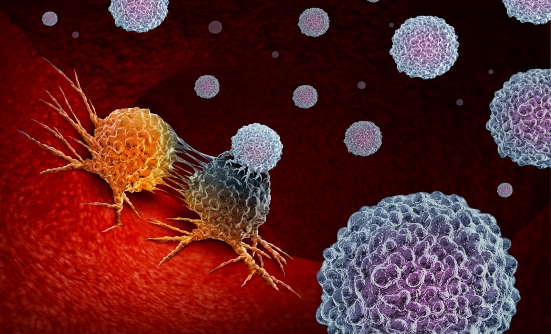Q: I was diagnosed with cancer involving my tonsils (head and neck cancer) last year and had surgery and chemoradiation. I notice that I have some swelling in my neck and face. My doctor said I have lymphedema and recommended physical therapy.
Treatment for cancer of the tonsils, as with cancer of any area of the head and neck, may require removal of lymph nodes. Lymph circulates through the skin and mucous membranes of the body, carrying foreign or harmful substances to lymph nodes to destroy or contain them to limit the spread of the tumor.
Neck surgery is used to remove some of the lymph nodes that drain the area affected by the cancer. These lymph nodes are under the jaw, behind the windpipe, and under a muscle in the neck (called “sternocleidomastoid”) that allows the head to turn.
These lymph nodes drain fluid from the mouth, throat, face, jaw, and the side of the neck. There are many interconnecting chains of lymph vessels and lymph nodes around the head and neck to carry the lymph fluid.
Surgery
During the removal of the cancer and lymph nodes by surgery, the surgeon will gently move nerves, muscles, veins, and arteries out of the way. Lymphedema is just one of a spectrum of impairments after head and neck cancer that should be treated together by rehabilitation professionals. Sometimes when nerves are stretched during surgery, they stop functioning for weeks or months. In most cases, nerves to the neck are not cut. The most common nerve to be stretched is called the “spinal accessory nerve,” which is the power source for the upper trapezius muscle, a large triangular muscle that extends from the back of the neck over the shoulder blade.
When the spinal accessory nerve stops conducting messages to the upper trapezius, there is winging of the shoulder blade and difficulty raising the arm overhead. When this occurs, ask for a referral to a physiatrist (a doctor trained in physical medicine and rehabilitation) to evaluate for nerve injury or other mechanical problems of the neck and shoulder that can occur, such as rotator cuff trauma, pain, and neck weakness.
Swelling After Neck Surgery
Swelling from neck surgery can involve structures inside the mouth, such as the tongue and swallow muscles in the throat, as well as the face, chin, and neck. When only a few lymph nodes are removed, there is usually a brief period of swelling that resolves on its own. In most cases, such swelling does not need treatment by a lymphedema therapist.
But if the early postoperative swelling restricts movement, causes difficulty swallowing, or is cosmetically concerning, it still should be treated by a lymphedema therapist to optimize function. The therapy involves a special massage technique called “manual lymphatic drainage,” along with compression pads to help this early swelling to resolve.
If the swelling persists or if it returns, it is then classified as true lymphedema and must be treated by a lymphedema therapist.
Radiation and Chemotherapy
Lymphedema in tonsil cancer most often occurs in patients undergoing radiation after surgery. Chemotherapy is often given with radiation therapy to enhance the effects of the radiation. One of the effects of radiation, or chemoradiation, may be tightness and hardening in the skin and muscle, called “fibrosis.” This can occur weeks or months after the end of radiation, leading to difficulty turning the neck and constriction of the lymph vessels. In head and neck cancer, restricted mobility and lymphedema need to be treated together.
Many people have weakness and fibrosis of the swallow muscles after surgery and chemoradiation for tonsil cancer. It is also important to begin swallow exercises, tongue and jaw range of motion, and strengthening as soon as possible.
Typical areas of swelling are seen under the chin, on the front of the neck, and along the jaw. The swelling can also include the cheek, lip, or soft tissues around the eyes or ears.
Lymphedema therapy is very beneficial in treating the lymphedema and soft-tissue scar.
Lymphedema Therapists
Lymphedema therapists use a variety of massage and tissue-elongation techniques to gently soften and stretch the scarred areas, and stimulate lymph flow in other areas of the head and neck to take over for the “blocked” areas.
The therapist may also use elastic garments and specialized foam pads to move fluid out of swollen areas and soften skin. In most cases, these pads are worn part time at home. They may need to be custom made by a lymphedema garment fitter to be comfortable and not restrict breathing or movement.
Since the tight tissues and lymphedema restrict range of motion in the jaw and neck, the lymphedema therapist will also provide stretching exercises. Because lymphedema and soft-tissue restrictions may also occur in the mouth, tongue, or throat, referral to a speech therapist may be useful.
In some cancer rehabilitation centers, speech therapists do lymphedema therapy and soft-tissue stretching treatment that consist of massage and exercises. In other centers, the physical therapist and occupational therapist are trained to do this type of treatment. As time goes on, fibrotic tissue becomes less elastic and the lymphedema becomes less mobile, so it is important to seek treatment as soon as these changes are noticed.
When treatment is delayed, there can be difficulty moving the tongue and jaw, as well as choking or aspiration (food and liquid getting into the lungs). Therapy for swallowing is done by speech therapists who specialize in the treatment of head and neck cancer.
Cancer Rehabilitation
A physiatrist can do a complete evaluation of all of these areas of concern. The physiatrist may do a study called an electromyogram to determine the exact nerves that have been affected to guide effective treatment. The physiatrist may also order a radiologic swallow test called a videoswallow, which is performed by a speech therapist along with a radiologist.
The physiatrist may also prescribe a muscle relaxant or a medication for nerve pain, such as Neurontin (gabapentin), along with physical therapy. Therapy for lymphedema may be done concurrently with physical therapy for the shoulder and neck and swallow therapy.
Patients with tonsil cancer have many challenges during and just after treatment, including many appointments and treatments. It may feel overwhelming to also have rehabilitation therapy, but it is worth the effort.
Studies have shown that patients who have early cancer rehabilitation have faster and better recovery of daily functions, including eating, driving, lifting, and enjoying activities that give meaning to their lives.














